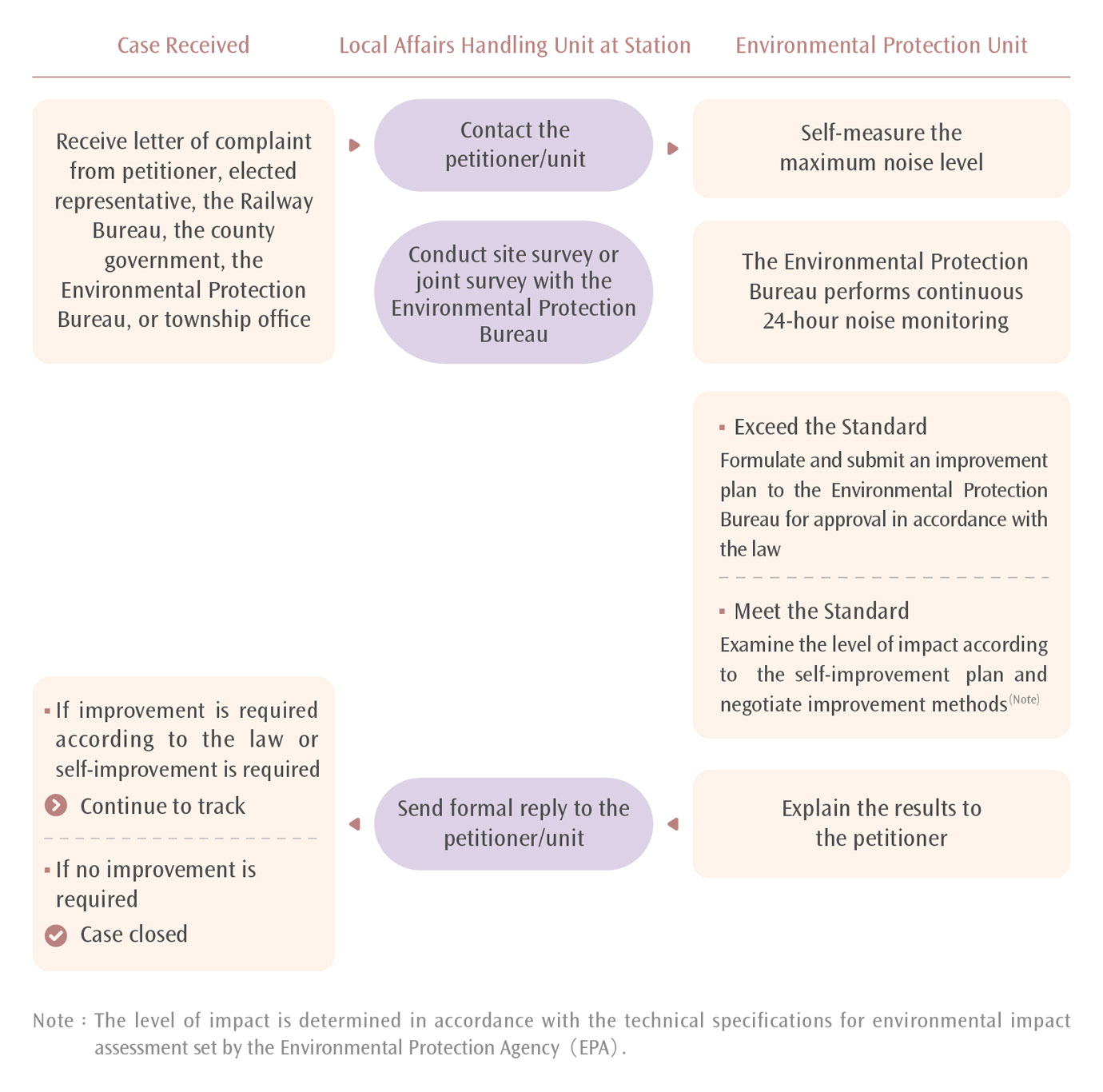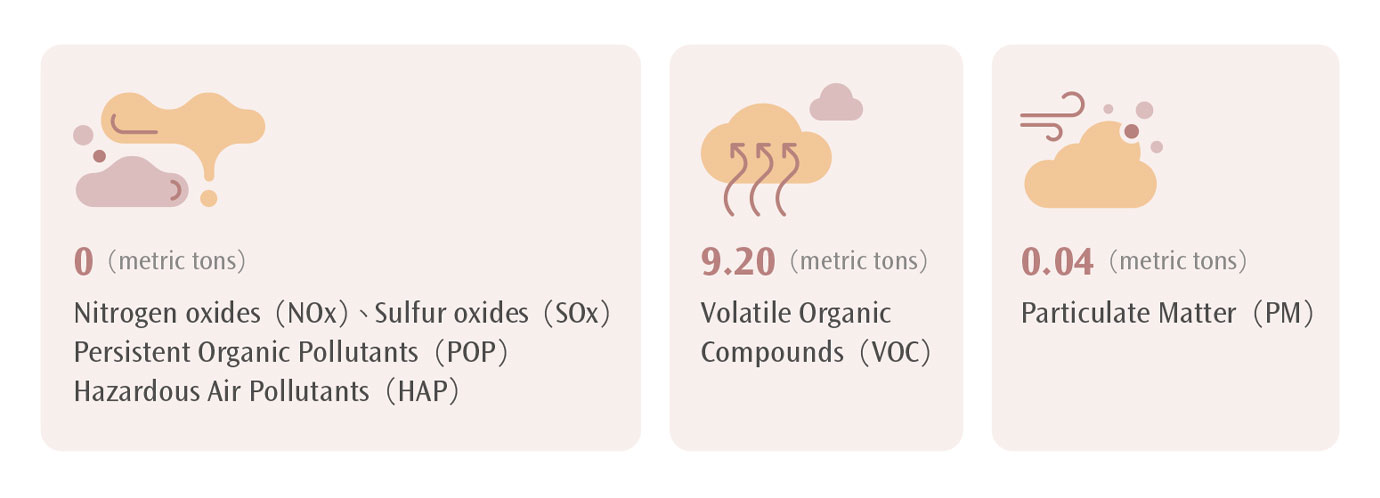Noise and Air Pollution Management

Noise and Vibration Management
THSRC has formulated the “High Speed Rail Noise Improvement Plan” and the “Noise & Vibration Petition Treatment for HSR During Operation,” and established the “High Speed Rail Noise Case Handling Process” to implement the most complete noise handling and prevention procedures. Executives at each station participate in activities and communicate with local opinion leaders and residents to achieve a win-win situation through communication. In 2024, THSRC deal with 15 high-speed railway noise issues along the line and 1 case occurred in Zhongshan Rd, Luzhu District, Taoyuan City, has exceeded the requirements of the “Land Transportation System Noise Control Standards.” THSRC has properly handled the issue with noise improvement plan, other issues were related on night-time operation noise affected to neighborhood. THSRC will improve communication with neighborhood to notify them 1-2 weeks in advance, and also, we reduced the broadcast volume during night-time operation. In 2024, 1 violation of noise issue was notified by the local Environment Protection Bureau that required improvement. Please refer to the table below for relevant handling conditions.
THSRC Noise Petition Handling Process

Number of Noise Petitions and Related Handling Statuses in the Most Recent Years
| Year | Number of Items | Need to be Improved | Remarks |
|---|---|---|---|
| 2024 | 15 | 1 | This noise petition is in Luzhu District, Taoyuan City. In this case, residents complained about the noise from high speed rail, so the Department of Environmental Protection, Taoyuan conducted 24 -hour noise monitoring in October, 2024. The results showed that the average maximum volume of the high speed rail in this area exceeded the requirements of the "Land Transportation System Noise Control Standards." THSRC has appropriately addressed this issue through the dedicated task force. |
| 2023 | 16 | 1 | One public petition case has been received, residents complained about the noise from high speed rail, so the Department of Environmental Protection, Taoyuan conducted 24 -hour high speed rail traffic noise monitoring in October, 2023. The results showed that the average maximum volume of the high speed rail in this section exceeded the requirements of the "Land Transportation System Noise Control Standards", and it was required to formulate a noise improvement plan within 180 days upon receipt of the notification from the competent authority. There was no any penalty by the authority. |
| 2022 | 19 | 1 | One public petition case in Waipu District, Taichung City has been received. In this case, residents complained about the noise from high speed rail, so the Department of Environmental Protection, TaiChung conducted 24 -hour high speed rail traffic noise monitoring in October, 2022.The results showed that the average maximum volume of the high speed rail in this section exceeded the requirements of the "Land Transportation System Noise Control Standards", and it was required to formulate a noise improvement plan within 180 days upon receipt of the notification from the competent authority. THSRC has properly handled the issue and submitted the noise improvement plan for review on November 15, 2023. Environmental Protection Bureau has confirmed and replied on February 21, 2024. |
| Total | 50 | 3 | - |
Air Pollution Management
THSRC's main operating mode relies on the power system. Although there are no issues with air pollutant emissions during regular operation, a small amount of emissions may still be generated during train maintenance at the Yanchao Main Workshop. In this regard, the automated spray painting factory of Workshop was constructed since 2021 and was expected to be completed by the end of 2025 with air pollution control equipment, including manual painting factory, adding a central control system, automatic painting robot arm, electric self-propelled trolley (replacing bogie), automatic car washing (sewage recycling) equipment, and grinding and lifting platform and pulse bag dust collectors, activated carbon adsorption equipment, as well as catalyst incineration towers and other equipment, which are used to treat dust and volatile organic compounds (VOCs) generated during the spray painting process of trains. It is anticipated to be effective in the prevention and control of air pollutant emissions.
THSRC also obtained a stationary pollution source installation permit, and a stationary pollution source operation permit. Additionally, a report is regularly filed every quarter in accordance with the Ministry of Environment's “Administrative Measures for the Reporting of Stationary Pollutant Emissions in Public and Private Places.” THSRC not only continues to perform environmental monitoring and environmental protection work through the Company's environmental management system, but conducts audits on the treatment of wastewater, waste and air quality at the Company's stations and maintenance depots through external environmental protection teams as well. In 2024, there was no punishment or penalty imposed by the competent authority due to environmental pollution.
In 2024, the total air pollution emissions from THSRC were 9.24 metric tons. Please refer to the table below for the emissions of different types of gases:
